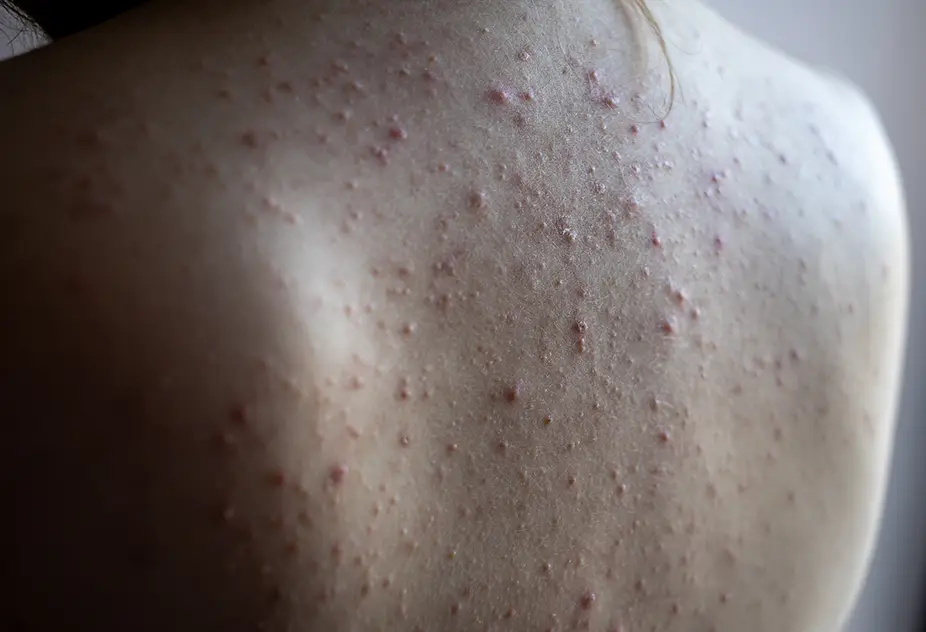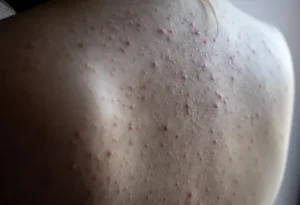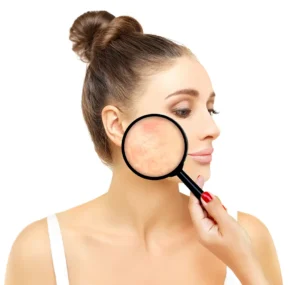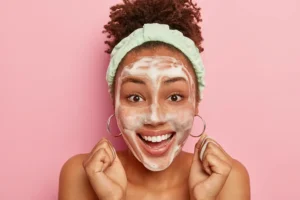Back acne, often called “bacne,” can be stubborn, painful, and frustrating. It affects up to half of people with facial acne and develops when excess oil, sweat, and bacteria clog pores on the back. Because the skin in this area is thicker and exposed to constant friction, breakouts can last longer and lead to scarring.
This guide explains what causes back acne, how to recognize it, the most effective treatments, and how to keep it from returning.
What Is Back Acne
Back acne is a form of acne vulgaris that appears on the upper and lower back, shoulders, and sometimes the chest. It happens when pores become blocked by sebum (oil), dead skin cells, and bacteria. The back has a high concentration of sebaceous glands, making it especially prone to breakouts.
Lesions range from small whiteheads and blackheads to inflamed papules, pustules, and deep cysts.
Why Back Acne Develops
1. Excess Oil and Dead Skin
Sebum production is higher on the back than on most body areas. When oil mixes with dead skin cells, it blocks pores and creates an environment where Cutibacterium acnes bacteria can thrive.
2. Sweat and Friction
Sweat trapped beneath tight clothing or backpacks promotes bacterial growth and irritation. This condition, called acne mechanica, is common among athletes and people who wear heavy gear.
3. Hormonal Changes
Fluctuations in hormones like testosterone increase oil production. That’s why bacne often worsens during puberty, menstrual cycles, or periods of stress.
4. Genetics
If close family members struggle with acne, you may be more likely to develop back breakouts due to inherited sebum and skin cell turnover patterns.
5. Pore-Clogging Products
Heavy conditioners, body oils, and some sunscreens can clog pores and worsen inflammation, especially when combined with friction or sweat.
How to Recognize Back Acne
Back acne often appears as clusters of red or pus-filled bumps on the upper back, shoulders, or along the spine. Severe forms may include painful cysts that sit deep under the skin.
Unlike folliculitis, which targets hair follicles and may itch, bacne lesions usually feel sore and appear in oil-rich zones. After healing, red or brown marks known as post-inflammatory erythema (PIE) and post-inflammatory hyperpigmentation (PIH) often remain.
Effective Treatments for Back Acne
1. Over-the-Counter Options
-
Benzoyl Peroxide (5–10%) kills C. acnes bacteria and reduces inflammation. Use a wash-off cleanser daily in the shower.
-
Salicylic Acid (1–2%) exfoliates inside pores, preventing new blockages. Look for sprays or gels to reach the upper back.
-
Sulfur or Zinc Formulas help control oil and calm redness.
2. Prescription Medications
-
Topical Retinoids (adapalene, tretinoin) regulate skin cell turnover and prevent clogged pores.
-
Oral Antibiotics reduce bacteria and inflammation in moderate to severe cases.
-
Hormonal Therapies such as birth control pills or spironolactone are effective when acne is hormone-driven.
-
Isotretinoin (Accutane) may be prescribed for severe, resistant bacne that causes scarring.
3. Professional Treatments
-
Chemical Peels with salicylic or glycolic acid improve texture and discoloration.
-
Laser or Light Therapy targets bacteria and reduces oil production.
-
Microdermabrasion or Extractions may be used for persistent clogged pores under dermatologist supervision.
4. Supportive Skincare Routine
-
Use fragrance-free, non-comedogenic body washes and moisturizers.
-
Avoid scrubbing; friction can worsen inflammation.
-
Exfoliate gently once or twice a week with chemical exfoliants, not harsh scrubs.
Preventing Back Acne
1. Hygiene and Lifestyle
-
Shower immediately after sweating or workouts.
-
Wear loose, breathable fabrics to reduce heat and friction.
-
Wash sheets, towels, and workout clothes regularly.
-
Avoid sitting in damp clothing for long periods.
2. Hair and Product Care
-
Rinse conditioner thoroughly to keep residue off your back.
-
Tie long hair up during exercise.
-
Use lightweight, oil-free sunscreen designed for acne-prone skin.
3. Nutrition and Stress
Emerging research suggests diets high in sugar or dairy may influence acne in some people. Focus on whole foods, drink plenty of water, and manage stress through rest or movement.
Treating Back Acne Marks and Scars
Even after active acne heals, discoloration can remain.
-
PIE (red or pink marks): Improve with niacinamide, azelaic acid, and laser therapy.
-
PIH (brown marks): Fade with gentle exfoliants, retinoids, and consistent sunscreen use.
-
Scars: Deeper indentations may require professional procedures like microneedling or resurfacing.
Healing takes time, but a consistent routine makes a visible difference.
When to See a Dermatologist
Seek professional care if:
-
Over-the-counter treatments haven’t improved acne after 8 weeks.
-
You have painful cysts or nodules.
-
You notice scarring, dark marks, or recurrent breakouts despite good hygiene.
A dermatologist can tailor oral or topical prescriptions and prevent long-term damage.
FAQs About Back Acne
Why do I get acne on my back but not my face?
The back has larger oil glands and thicker skin, which makes clogged pores more likely.
Does sweating make back acne worse?
Yes. Sweat mixed with oil and bacteria creates the perfect environment for breakouts. Shower promptly after workouts.
Can tight clothing cause acne?
Yes. Friction and trapped moisture from tight fabrics irritate pores and increase inflammation.
How can I prevent back acne scars?
Avoid picking or scratching lesions, treat acne early, and use sunscreen to minimize post-acne marks.
Are home remedies effective?
Some, like diluted tea tree oil, may help mild cases, but dermatology-backed treatments show better long-term results.





